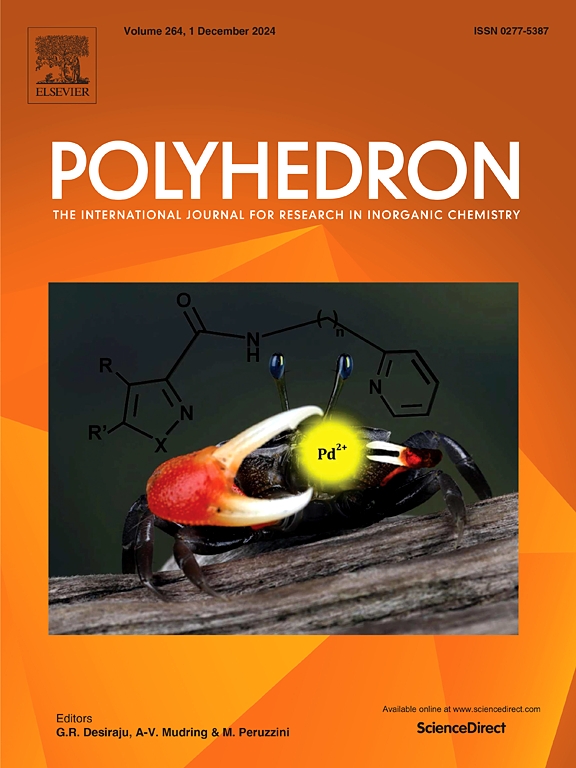Mono(guanidinate) chromium(II) chloride complexes: Selective synthesis and structural characterization
IF 2.4
3区 化学
Q2 CHEMISTRY, INORGANIC & NUCLEAR
引用次数: 0
Abstract
Reaction of the lithium salts of the two sterically bulky guanidinate ligands, {Li[RC(NAr)2]} (Ar = 2,6-diisopropylphenyl; R = N(CH2)5 (1); R = NCy2 (2)) with one equivalent of CrCl2 in tetrahydrofuran (THF) at room temperature yielded the corresponding chloride-bridged binuclear complexes, [{(CH2)5NC(NAr)2}Cr(µ-Cl)2Cr(THF){(CH2)5NC(NAr)2}] (3) and [{Cy2NC(NAr)2}Cr(µ-Cl)]2 (4). These are rare examples of binuclear mono(guanidinate) chromium(II) chloride complexes without the formation of chromium “ate” complexes. Both complexes were characterized by single crystal X-ray analysis that showed strong boat-like distortions around the chromium centers. In compound 3 the coordination of one THF molecule to one of the Cr leads to two different coordination environments. In 4 both Cr atoms are four coordinated and show distorted square planar geometries around the chromium center. Nearly identical C–N bond lengths show considerable interaction of the lone pair of the non-coordinating N-atom with the conjugated NCN moiety. The three-dimensional Hirshfeld surface analysis and the two-dimensional fingerprint plots showed that H⋯H interactions, H⋯C/C⋯H and H⋯Cl/Cl⋯H H–bonds were the main and at times the strongest contributions for the intermolecular interactions.

单(胍)二氯化铬配合物:选择性合成和结构表征
[Li[RC(NAr)2]} (Ar = 2,6-二异丙基苯基;R = n (ch2)5 (1);R = NCy2(2))与CrCl2在四氢呋喃(THF)中的等量在室温下产生相应的氯桥联双核配合物,[{(CH2)5NC(NAr)2}Cr(µ-Cl)2Cr(THF){(CH2)5NC(NAr)2}](3)和[{Cy2NC(NAr)2}Cr(µ-Cl)]2(4)。这些是罕见的双核单(胍)铬(II)氯化配合物而不形成铬“酸”配合物的例子。这两种配合物的单晶x射线分析表明,在铬中心周围有强烈的船状扭曲。在化合物3中,一个THF分子与一个Cr分子的配位导致两种不同的配位环境。在4中,两个铬原子都是四配位的,并在铬中心周围呈现扭曲的方形平面几何形状。几乎相同的C-N键长度表明非配位n原子的孤对与共轭NCN部分有相当大的相互作用。三维Hirshfeld表面分析和二维指纹图谱显示,H⋯H相互作用,H⋯C/C⋯H和H⋯Cl/Cl⋯H氢键是分子间相互作用的主要贡献,有时是最强的贡献。
本文章由计算机程序翻译,如有差异,请以英文原文为准。
求助全文
约1分钟内获得全文
求助全文
来源期刊

Polyhedron
化学-晶体学
CiteScore
4.90
自引率
7.70%
发文量
515
审稿时长
2 months
期刊介绍:
Polyhedron publishes original, fundamental, experimental and theoretical work of the highest quality in all the major areas of inorganic chemistry. This includes synthetic chemistry, coordination chemistry, organometallic chemistry, bioinorganic chemistry, and solid-state and materials chemistry.
Papers should be significant pieces of work, and all new compounds must be appropriately characterized. The inclusion of single-crystal X-ray structural data is strongly encouraged, but papers reporting only the X-ray structure determination of a single compound will usually not be considered. Papers on solid-state or materials chemistry will be expected to have a significant molecular chemistry component (such as the synthesis and characterization of the molecular precursors and/or a systematic study of the use of different precursors or reaction conditions) or demonstrate a cutting-edge application (for example inorganic materials for energy applications). Papers dealing only with stability constants are not considered.
 求助内容:
求助内容: 应助结果提醒方式:
应助结果提醒方式:


